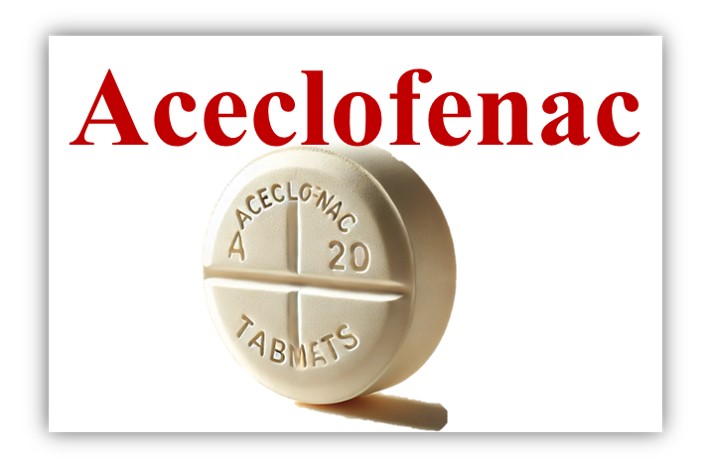OVERVIEW
Aceclofenac is a nonsteroidal anti-inflammatory drug (NSAID) primarily used to relieve pain and inflammation associated with a variety of conditions, including osteoarthritis (OA), rheumatoid arthritis (RA), and ankylosing spondylitis (AS).
DOSAGE
Adults
Standard dosage: The usual dose for adults is 100 mg, taken twice a day (one tablet in the morning and one in the evening).
Sustained-release formulation: For those using a sustained-release formulation, the dosage may be adjusted to 200 mg once daily.
Elderly
Elderly patients require special adjustments in dosage; they can take the same dose as adults (100 mg twice daily). However, caution is advised due to possible comorbidities.
Gel: Topical formulations for localized pain relief.
Injections: For patients who may have difficulty taking oral medications.
MECHANISM OF ACTION
Selective COX inhibition:
Aceclofenac exhibits better inhibition of COX-2 than COX-1. Research shows that it inhibits COX-2 by about 97%, while inhibiting COX-1 by about 46%. This selectivity is important because COX-1 is responsible for the production of prostaglandins that protect the gastric mucosa, while COX-2 is induced during inflammation and mediates pain and inflammation.
Prostaglandin synthesis:
By inhibiting COX-2, aceclofenac reduces the synthesis of pro-inflammatory prostaglandins, particularly prostaglandin E2 (PGE2). This reduction leads to a decrease in inflammation, pain, and fever associated with a variety of conditions such as osteoarthritis and rheumatoid arthritis.
Cytokine modulation:
Aceclofenac also affects the production of inflammatory cytokines. It has been found to be able to inhibit interleukin (IL)-1β, IL-6, and tumor necrosis factor (TNF), which are key mediators in the inflammatory response. By reducing these cytokines, aceclofenac further reduces inflammation and pain.
Cartilage-protective effects:
Interestingly, aceclofenac can stimulate the synthesis of glycosaminoglycans in cartilage, thereby having a protective effect against cartilage degradation.
Nitric oxide production:
Aceclofenac reduces the production of nitric oxide in human articular chondrocytes, another pathway involved in inflammation.
Neutrophil Adhesion:
This drug inhibits neutrophil adhesion to endothelial cells by reducing the expression of L-selectin (CD62L), which helps reduce inflammation at the site of injury.
ADVERSE DRUG REACTIONS
Gastrointestinal Issues
- Nausea
- Indigestion
- Abdominal pain
- Diarrhea
- Flatulence
- Constipation
- Vomiting
Central Nervous System
- Dizziness
- Headache
Hepatic Effects
- Increased liver enzymes
Renal Effects
- Increased blood urea and creatinine levels
Allergic Reactions
- Anaphylactic reactions, including shock
- Facial swelling
DRUG-DRUG INTERACTIONS
Anticoagulants
Aceclofenac may increase the effects of anticoagulants such as warfarin and acenocoumarol, which may increase the risk of bleeding and nosebleeds.
Corticosteroids
Its concomitant use with corticosteroids substantially increases the risk of gastrointestinal ulcers and bleeding.
Antiplatelet Agents
When combined with antiplatelet agents (such as aspirin) or selective serotonin reuptake inhibitors (SSRIs), the risk of gastrointestinal bleeding increases.
Quinolone Antibiotics
Taking quinolone antibiotics with aceclofenac may increase the risk of seizures.
Lithium
Aceclofenac may reduce the renal clearance of lithium, potentially resulting in increased serum levels and toxicity.
Methotrexate
Caution is advised when using aceclofenac within 24 hours of methotrexate, as this may increase plasma concentrations of methotrexate, possibly increasing the risk of toxicity.
Diuretics and ACE Inhibitors
Aceclofenac may reduce the effectiveness of antihypertensive medications, including diuretics and ACE inhibitors, which can increase blood pressure.
Zidovudine
Co-administration with zidovudine increases the risk of hematological toxicity, which requires careful monitoring.
NSAIDs
Using aceclofenac with other NSAIDs may increase the risk of adverse effects, especially gastrointestinal complications.
USE
Osteoarthritis: It helps reduce joint pain and stiffness associated with deterioration of cartilage.
Rheumatoid arthritis: This medicine reduces inflammation and pain in patients suffering from the long-term autoimmune disorder.
Ankylosing spondylitis: Aceclofenac is effective in managing spinal pain and stiffness caused by this type of arthritis.
Post-operative pain: It is used for short-term relief of pain after surgery.
Trauma-related pain: Aceclofenac may also be effective in treating pain resulting from injuries.
Other conditions: It can be used for toothache, low back pain, scapulohumeral periarthritis, and extra-articular rheumatism.

